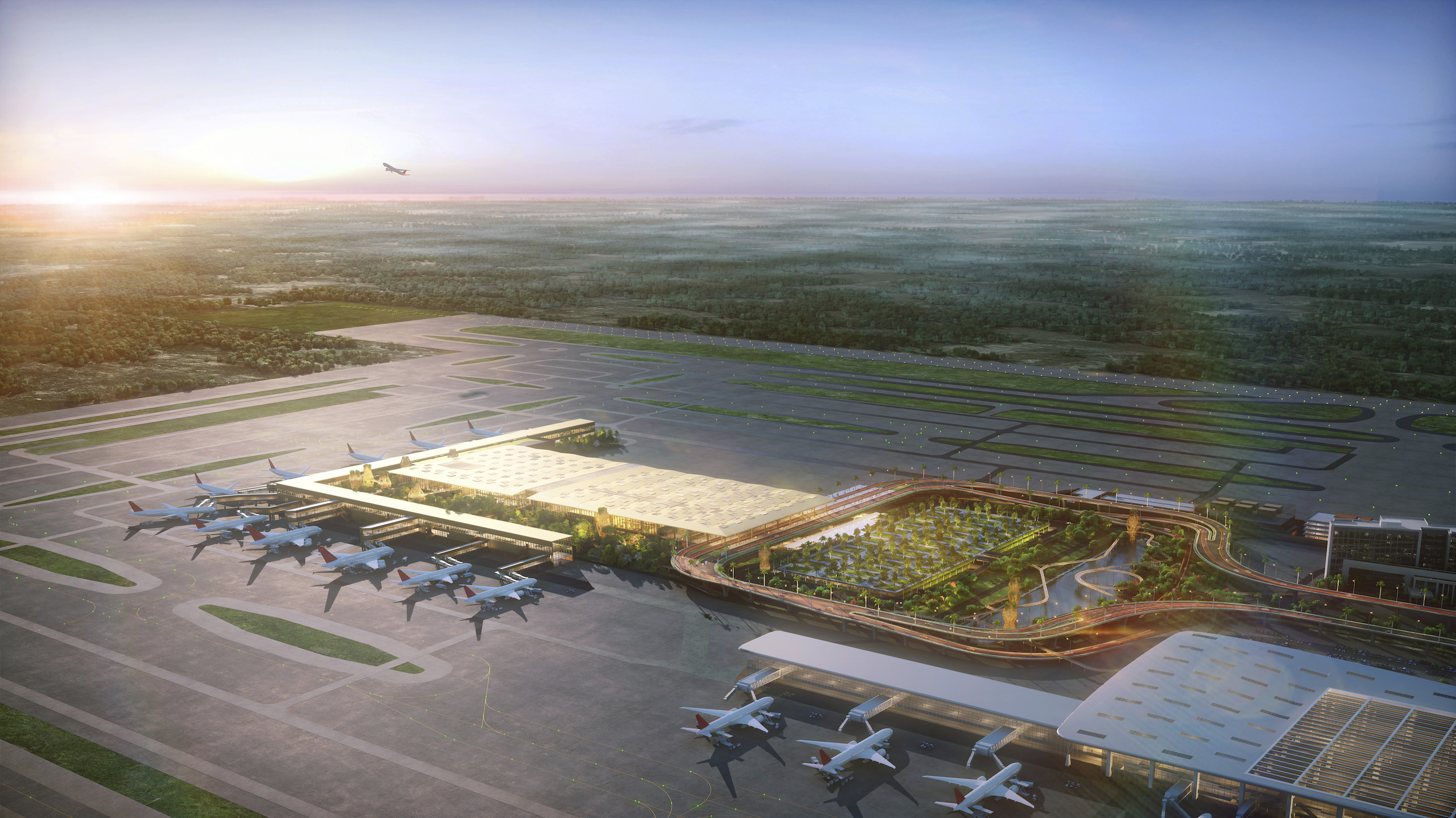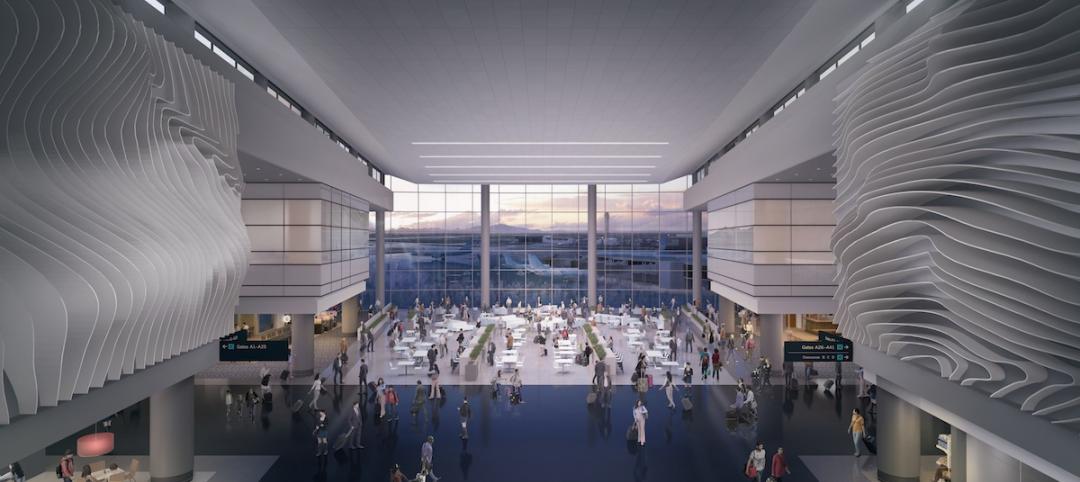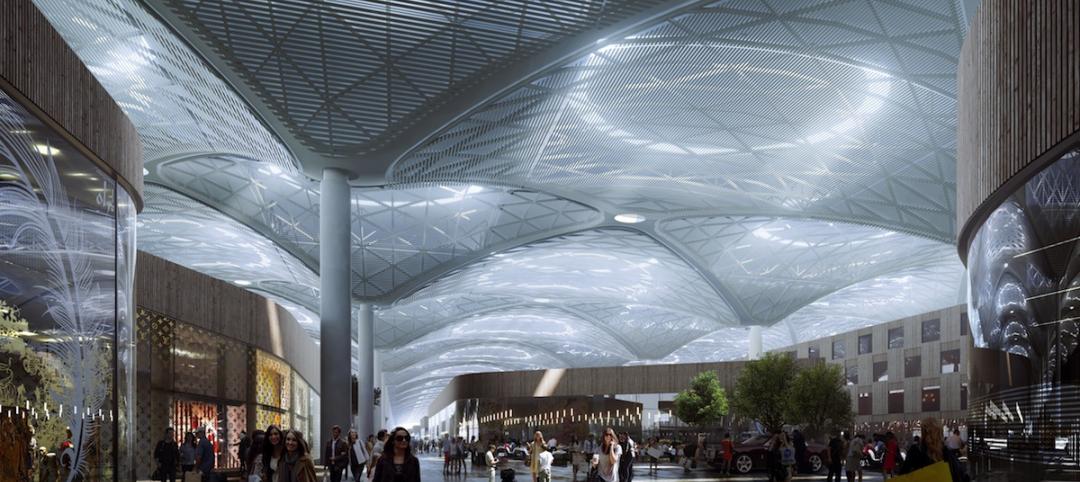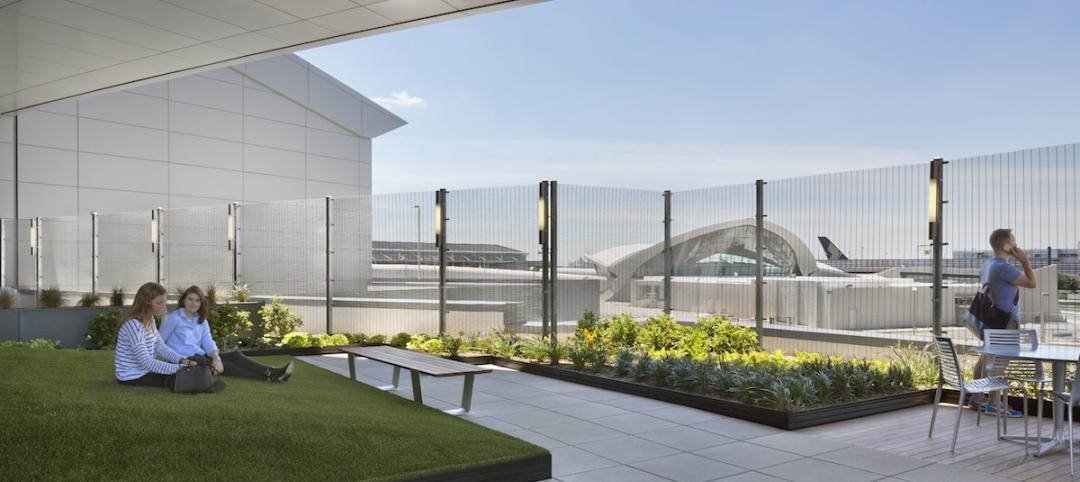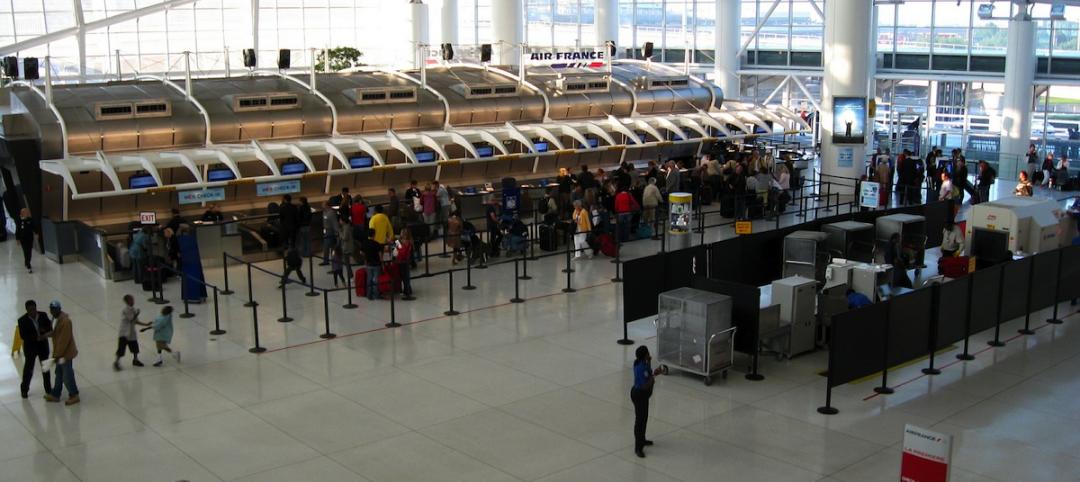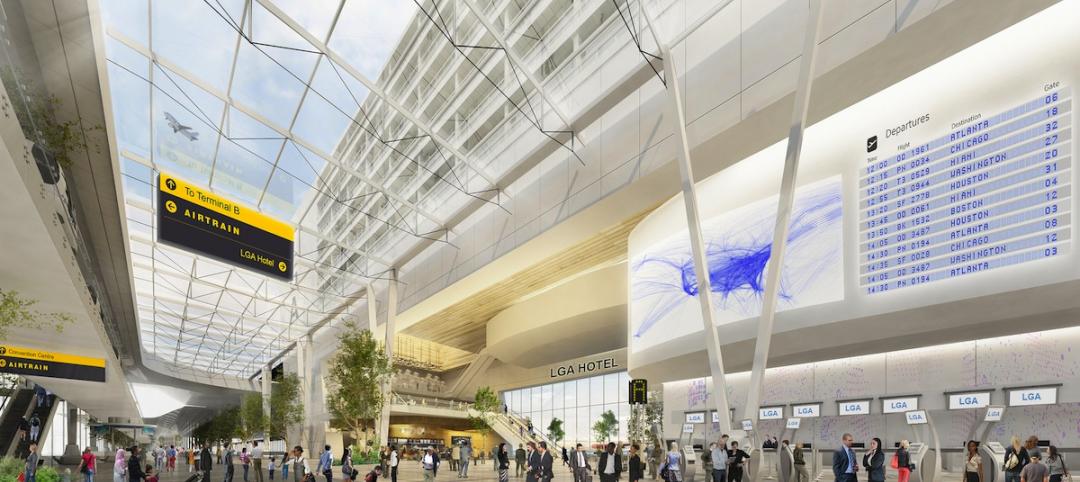Incorporating biophilia into a building’s architectural design has found its fullest expression lately in airports. Setting the bar when it opened in 2019 was the nature-themed Jewel Changi Airport, designed by Safdie Architects, which features an expansive indoor forest and a rain-fed waterfall that, at 40 meters, is the world’s tallest.
On January 15, 2023, Phase 1 of the Kempegowda International Airport’s Terminal 2, in Bengaluru, India, began domestic operations. The 255,661-sm (2.75 million-sf) building, designed by Skidmore, Owings & Merrill (SOM), is projected to process 25 million passengers annually, while providing its travelers with a healthier environment, thanks to extensive indoor-outdoor landscaping that offers serenity to what is normally a frenzied experience.
Phase 1 of Terminal 2 “allows for a sense of wonder and delight” with its outdoor gardens and exotic plants, says Peter Lefkovits, a Partner with SOM, whom BD+C interviewed a few weeks after the terminal opened. The building team on this project included the structural, civil, and facade engineer Buro Happold, which also provided structural and façades engineering services for the Jewel Changi Airport.
Airport terminal offers a natural connection to the outdoors
SOM’s involvement in the Kempegowda Airport project dates back to 2013, when it won a design competition. It worked with Arup on this project's MEP design. Lefkovits recalls that the client, Bangalore International Airport Ltd. (BIAL), “from the get-go” wanted its new terminal to reflect Bengaluru, known locally as the Garden City for its lush parks and gardens, and temperate climate despite being in southern India.
“We give the airport a lot of credit for its vision for a model of sustainability, even pre-pandemic,” says Lefkovits.
Working with the landscape architect Grant Associates and the lighting consultant Brandston Partnership Inc., SOM devised a terminal within a garden that connects passengers to nature. Travelers walking through the airport are exposed to more than 10,000 sm of green walls, hanging plants, and gardens inside a terminal whose buildings are interconnected by a continuous band of outdoor landscaped spaces.
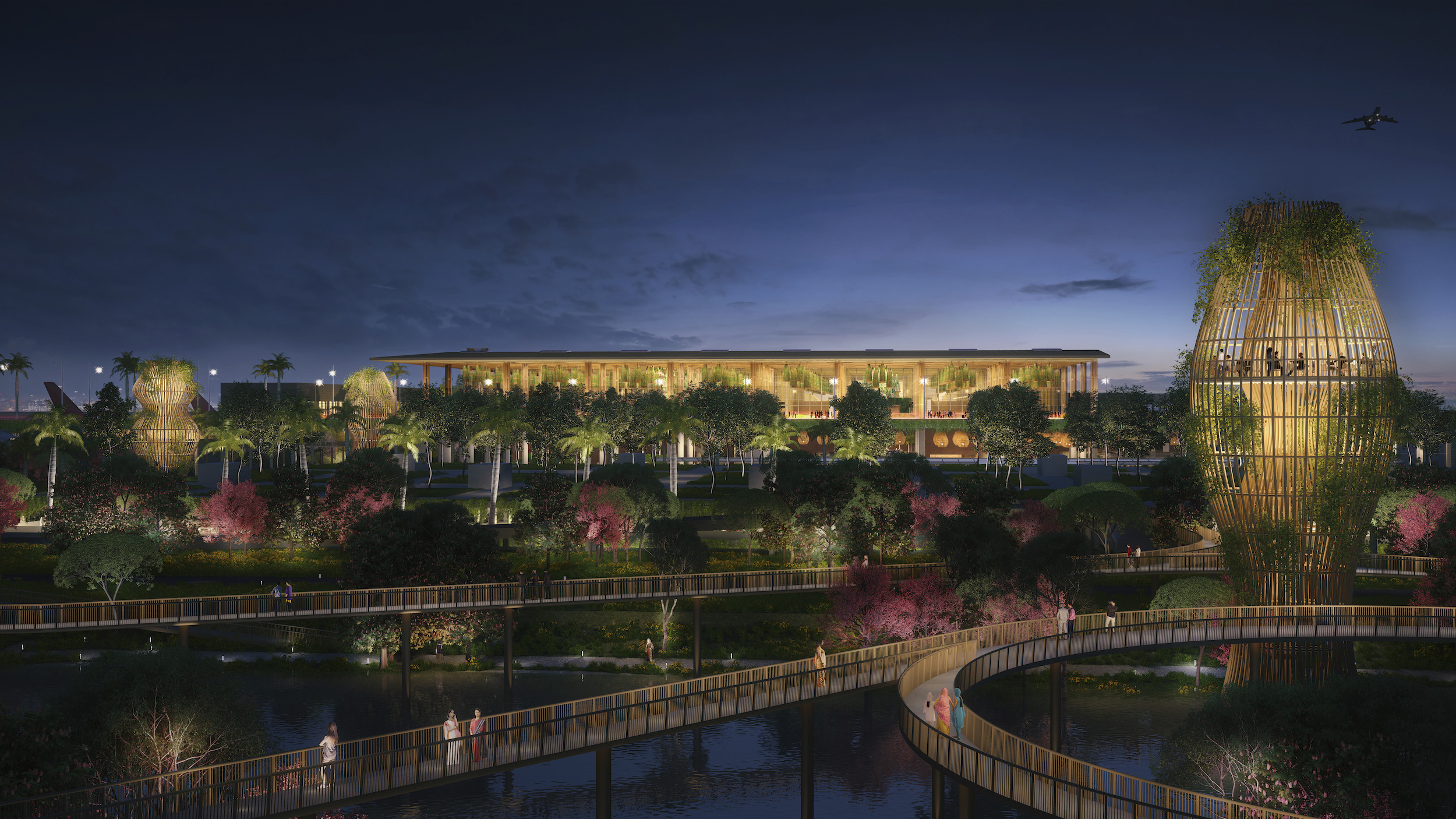
The main complex—which encompasses areas for check-in, baggage dropoff, and security checkpoints—is linked to an 11-gate boarding building by an outdoor, 24,000-sm “forest belt” that rises three stories and includes a series of open-air bridges for departures (upper floor) and arrivals (lower floor). Lefkovits notes that there’s a separate network of walkways that allows passengers to meander through the forest.
The outdoor garden surrounds a large lagoon that supports a nursery for maintaining the terminal’s plant life and provides graywater for the terminal’s operations.
The plant species throughout the terminal were chosen for their ruggedness. The flora has its own integrated irrigation system that is monitored by apps. Lefkovits adds that the plants were often placed to take advantage of the terminal’s skylights.
Bamboo abounds as a design feature of the airport terminal
From Day 1, the Building Team, which included the general contractor Larsen + Toubro and CM Turner Construction, worked under a specific budget that was set by regulatory authorities. Consequently, the building’s design is clean, efficient, and simple, Lefkovits says, without “structural gestures” and at the service of the gardens and passenger comfort.
The team used a “rich palette” of building materials that included domestic granite for the terminal’s flooring, and natural brick for its walls. “It doesn’t feel like an airport as much as a hotel,” says Lefkovits.
Contributing to that ambiance within the terminal is an abundance of hanging plants and natural light that filters through bamboo lattice. Indoor waterfalls in the building’s retail section help cool the interior. Terminal 2 also has one of the lightest roofs at this scale, made entirely from domestically produced materials. The roof above the retail and check-in halls features long-span steel frames supported by steel columns 18 meters apart, whose posts are clad in bamboo.
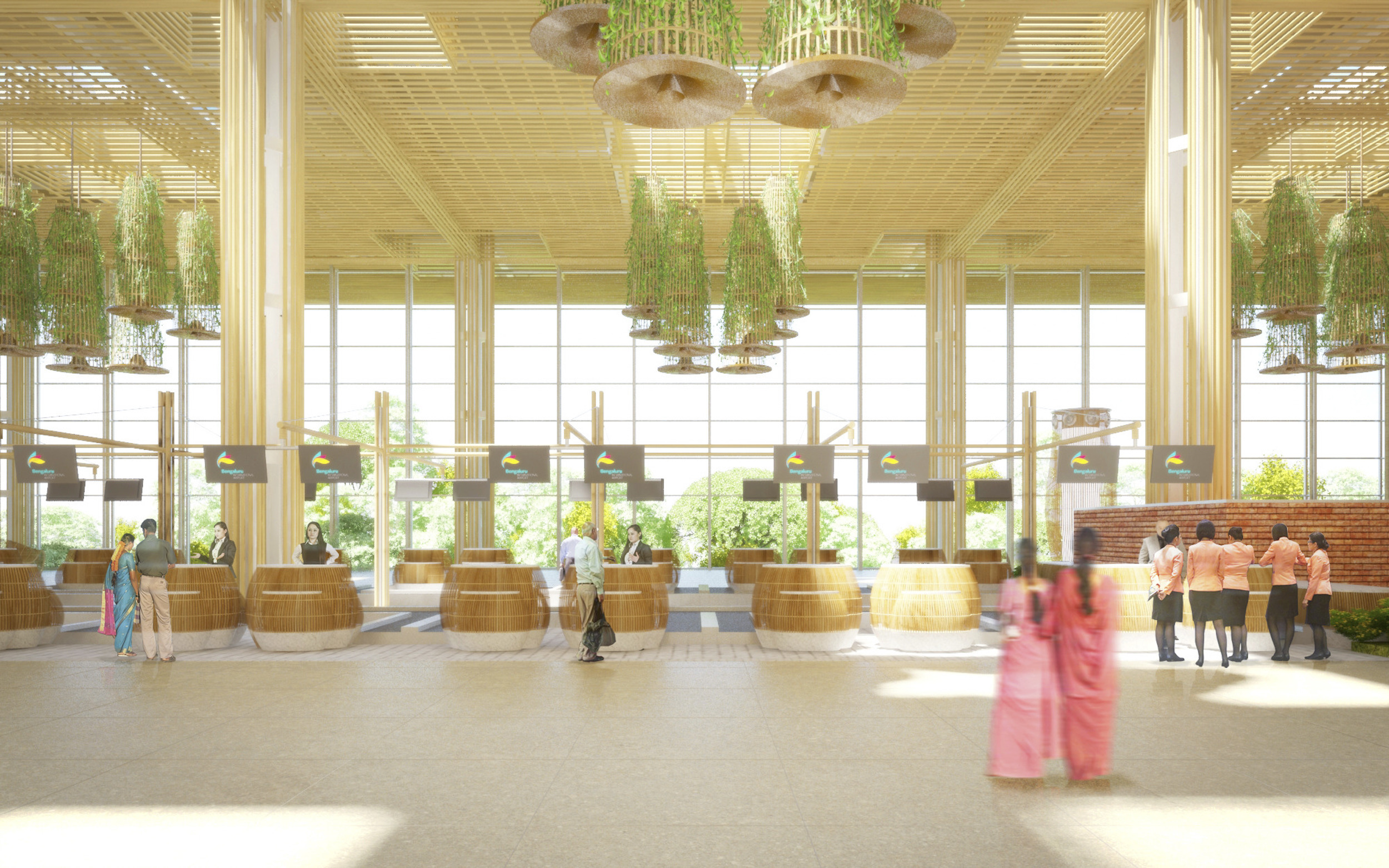
At the center of Kempegowda Airport, with Terminal 2 to its north and Terminal 1 to its southeast, is a 123,000-sm, T-shaped multimodal transit hub, the artery through which the entire complex can be accessed. As if a terminal within a garden isn’t unusual enough, the transit hub features an outdoor retail and entertainment area that the airport has positioned as a new civic center for the city. The gardens from Terminal 2 extend to the hub and its surrounding land. Two lagoons on the hub’s southern side recycle the airport’s stormwater runoff.
Related: BD+C's 2022 Airport Terminal Giants:
• Top 55 Airport Terminal Architecture and AE Firms
• Top 65 Airport Terminal Engineering and EA Firms
• Top 60 Airport Terminal Contractors and CM Firms
India’s Ministry of Civil Aviation estimated that Terminal 2 cost “around” 50 billion rupees to build, or the equivalent of US$604 million. Terminal 2 was designed and constructed to achieve LEED Gold certification. The building is run entirely on renewable energy. The terminal’s second phase, for which no start date has been announced yet, will increase its size to 450,000 sm, and its annual traveler capacity to 40 million.
Related Stories
Airports | Oct 30, 2015
HOK designs new terminal for Salt Lake City International Airport
The $1.8 billion building will have floor-to-ceiling windows, a spacious central "Canyon," and energy-efficient systems. It will open in 2020.
Airports | Oct 5, 2015
Perkins+Will selected to design Istanbul’s 'Airport City'
The mixed-use development will be adjacent to the Istanbul New Airport, which is currently under construction.
Airports | Sep 30, 2015
Takeoff! 5 ways high-flyin' airports are designing for rapid growth
Nimble designs, and technology that humanizes the passenger experience, are letting airports concentrate on providing service and generating revenue.
Airports | Sep 23, 2015
JFK Airport's dormant TWA terminal will be reborn as a hotel
After 15 years of disuse, the Googie architecture-inspired TWA Flight Center at New York’s John F. Kennedy International Airport will be transformed into a hotel. Gizmodo reports that the city’s Port Authority chose a renovation proposal from Jet Blue this week.
Giants 400 | Sep 17, 2015
AIRPORT SECTOR GIANTS: KPF, Hensel Phelps, Jacobs top rankings of nation's largest airport terminal sector AEC firms
BD+C's rankings of the nation's largest airport terminal sector design and construction firms, as reported in the 2015 Giants 300 Report.
Airports | Aug 31, 2015
Surveys gauge users’ satisfaction with airports
Several surveys gauge passenger satisfaction with airports, as flyers and airlines weigh in on technology, security, and renovations.
Airports | Aug 31, 2015
Small and regional airports in a dogfight for survival
Small and regional airports are in a dogfight for survival. Airlines have either cut routes to non-hub markets, or don’t provide enough seating capacity to meet demand.
Airports | Aug 31, 2015
Airports expand rental car facilities to ease vehicular traffic at their terminals
AEC teams have found fertile ground in building or expanding consolidated rental car facilities, which are the No. 1 profit centers for most airports.
Airports | Aug 31, 2015
Experts discuss how airports can manage growth
In February 2015, engineering giant Arup conducted a “salon” in San Francisco on the future of aviation. This report provides an insight into their key findings.
Airports | Jul 28, 2015
Plans to make over New York’s aging LaGuardia Airport are revealed
The complete redesign, devised by a panel of experts, would unify terminals, relieve ground traffic congestion, and install state-of-the-art amenities.


